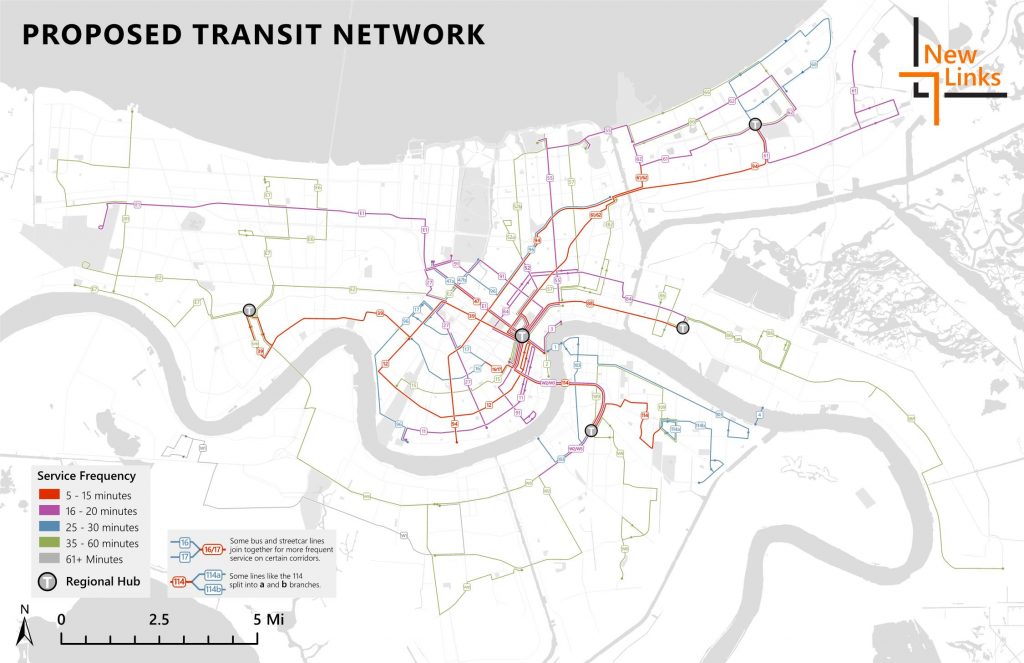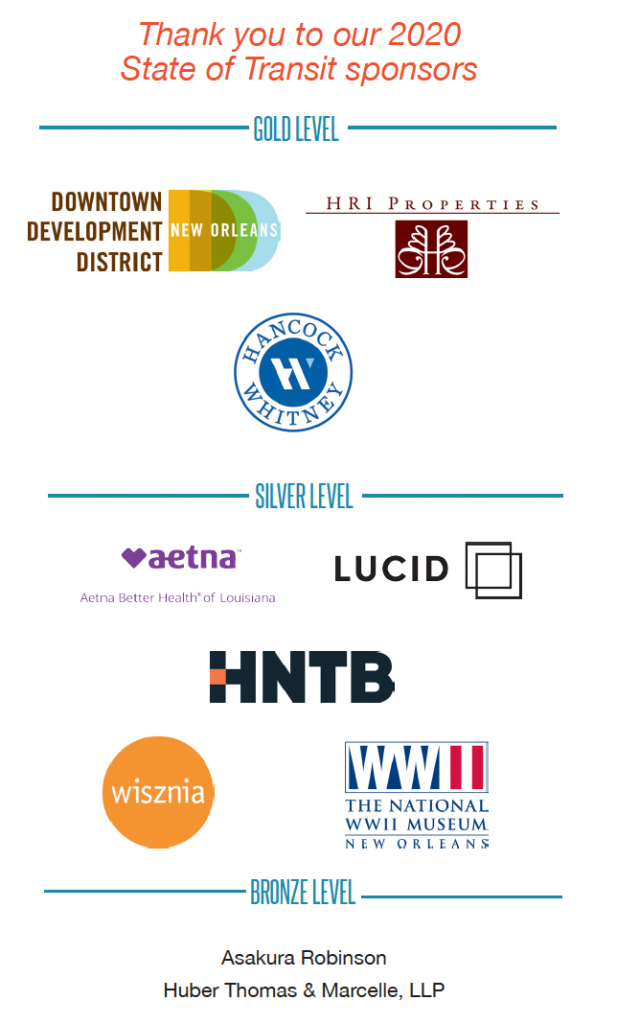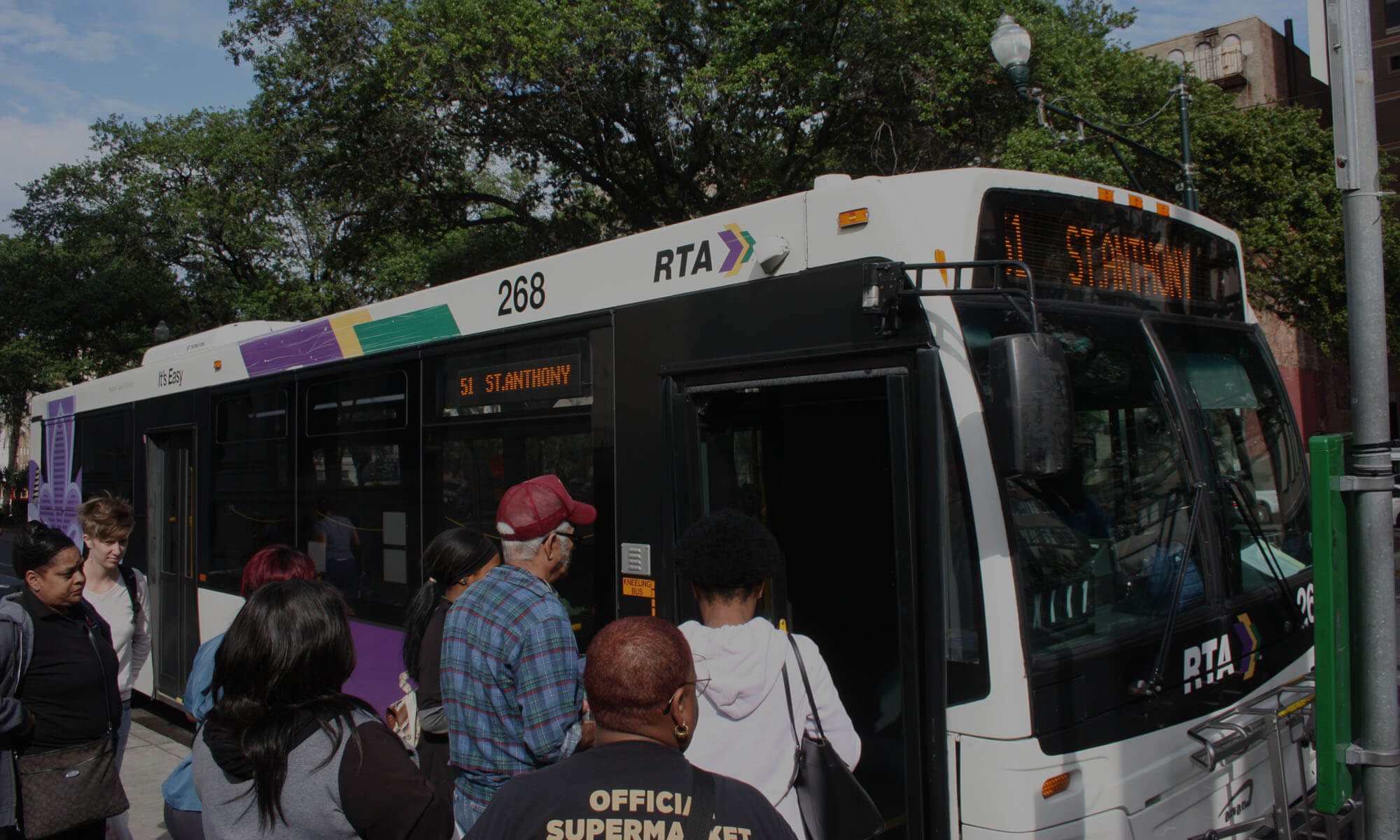(RE)DESIGNING OUR TRANSIT FUTURE


Read the 2020 State of Transit in New Orleans report here.
Big disparities continue to exist in New Orleans transit in 2020.
- Our research shows that fully half of Black households in New Orleans are in the worst bracket of access compared to only 26 percent of white households.
- Reliability continues to be a big problem for transit riders. On average, buses are only on time 73 percent of the time, with worse numbers for West Bank and New Orleans East riders.
- The regional divide continues to adversely affect those who can least afford it.
On top of all of this, comes the COVID-19 emergency, which has temporarily hollowed out sales tax collection – the main source of funding for the region’s biggest transit provider – the New Orleans Regional Transit Authority (RTA). Only emergency federal funding from the CARES Act and a reduction in service to Saturday-level service has kept the RTA from layoffs and much larger cuts. But that emergency money could be running out soon and the COVID-19 emergency continues to linger.
Despite all of this, Ride New Orleans is cautiously optimistic about the future of New Orleans transit. The biggest reason? After almost two years of community outreach, the New Links regional transit network redesign process released a proposal for a redesigned network in October 2020.
The New Links proposal would offer riders a redesigned network where buses would come more often, more reliably and get riders to more destinations in less time.
- New Links would take the regional transit system from a system where 2/3 of transit lines arrive very infrequently to a system where 2/3 of transit lines arrive at least every 30 minutes or less.
- New Links would mean big boosts for equity, with 2/3 of households without access to a vehicle within walking distance of a frequent transit line
- New Links would implement new high frequency regional transit lines connecting major jobs centers on both sides of the Orleans/Jefferson parish line
New Links can be a game changer for New Orleans region transit riders – especially as the regional economy starts to recover from the effect of the COVID-19 emergency. But for that to happen, regional decision makers must decide to start implementation. The story for next year’s State of Transit report will hinge on whether transit leaders have the courage and wisdom in the coming months to approve and begin implementation of New Links, taking the necessary steps to finally move beyond a status quo that is unworthy of riders and the region.
- PREVIOUS STATE OF TRANSIT REPORTS
-
2019: NEW LINKS AND NEXT STEPS
Read the 2019 State of Transit in New Orleans report here.
Ride New Orleans presents our sixth State of Transit in New Orleans report, an annual examination of how the region is doing in providing bus, streetcar, and ferry service. Our key findings include:
- New Orleans region has made progress in regional transit coordination and planning. We’ve seen the implementation of a true cross-parish regional route for the first time in many years and the start of a new regional transit pass that allows riders unlimited travel on either the New Orleans Regional Transit Authority (RTA) or Jefferson Transit (JeT) systems.
- Strong new leadership at the RTA has also made the bold and necessary decision to return the agency to full public control after a decade of de facto privatized control via the delegated management model. This is a big win for transparency, accountability, and continuity.
- These operational and structural steps forward are important and can set the tone for future comprehensive improvements. Those improvements are still badly needed. The average transit-reliant New Orleanian can still only reach 12 percent of the region’s jobs in 30 minutes-or-less. Promised bus stop shelters mostly have yet to materialize, and RTA buses were only on-time 74 percent of the time last year. 18 of 39 lines performed worse than they did in 2016 and many individual lines serving transit-reliant neighborhoods in New Orleans East or Algiers perform even worse.
- Fortunately, the opportunity is there to change this on a tangible level within the next year. The New Links network redesign – slated for completion in 2020 – can redraw transit lines to better serve today’s riders – especially in the East and Algiers – and create seamless regional connections.
-
2018: FROM PLANS TO ACTION
Read the 2018 State of Transit in New Orleans report here.
Ride New Orleans presents our fifth State of Transit in New Orleans report, an annual examination of how the region is doing in providing bus, streetcar, and ferry service. Our key findings include:
- The table has been set for future progress through the passage of the RTA’s Strategic Mobility Plan (SMP) – the first comprehensive post-Katrina strategic plan for the agency. The SMP is designed to guide agency priorities for the next two decades.
- A new Mayor also quickly made an impact on transit by appointing three new RTA board board members focused on reform. This is especially important as the RTA board decides whether to move to a new contracting model over the next year. The decade-long “delegated management” contract with Transdev expires in August 2019.
- Despite continued progress, we’re still falling short in a key area – helping people get to where they need to go. The average New Orleanian with a car can reach 89 percent of the region’s jobs in 30 minutes or less, but residents who take the bus, streetcar, or ferry can, on average, only reach 12 percent of the region’s jobs in the same time period. These numbers are basically unchanged over the last two years.
- Day-to-day RTA spending priorities continue to be troublesome in certain areas. This year alone, the RTA could spend up to $624,000 studying a short streetcar extension that is not included in the SMP and would do nothing to increase access to jobs.
- To address key deficiencies and continue progress, RIDE recommends a focus on SMP implementation, taking steps to start a network redesign process, advancing regional connectivity, and developing a new more transparent and accountable model of RTA governance as the current operations contract comes to an end.
- Download the report here.
-
2017: CREATING OUR TRANSIT FUTURE
Read the 2017 State of Transit in New Orleans report here.
Ride New Orleans presents our fourth State of Transit in New Orleans report, an annual examination of how the region is doing in providing bus, streetcar, and ferry service. Our key findings include:
-
-
- Despite continued progress, we’re still falling short in a key area – helping people get to where they need to go. The average New Orleanian with a car has vastly better access to economic opportunity than transit-reliant New Orleanians.
- Unfortunately, our biggest recent capital investment – the Rampart/St. Claude and Loyola streetcar extensions – did nothing to help with access to jobs. We dedicated $75 million in public money to the project, but residents along the Rampart/St. Claude corridor saw a slight reduction in total jobs accessible in 30 minutes or less via transit.
- But we also saw positive momentum. At the same point that the Rampart/St. Claude streetcar extension opened, the RTA also reconnected the #15 Freret and #28 Martin Luther King bus lines to Canal Street. This very low-cost move, made a big difference. Collectively, riders along those corridors were able to reach 5,000 more jobs in 30 minutes or less via transit.
- The RTA’s strategic mobility plan – the long-range plan expected to be completed by the end of the year – has a lot of potential to create a clearly defined path toward improvement. But that will require the right kind of details and specifics be filled in over the remaining months of the planning process.
-
2016: Access. Accelerate. Achieve.
Our key findings include:
-
-
- We have made undeniable progress : The 2015 and 2016 service enhancements were a needed step in the right direction. In April 2016, the New Orleans Regional Transit Authority (RTA) added about 11% additional vehicle revenue hours (VRH – the time that a transit vehicle is actively serving paying customers) with a focus on expanding later evening and early morning trips. Overnight transit service was added on eight lines, raising the total of lines providing 24-hour service to nine. Early morning service was added to 15 lines. Additional weekend service was added, increasing the total amount of weekend service by 28 percent.
- But we are still falling short: We are not providing reliable access to jobs and other opportunities via transit for the New Orleans residents who need it the most. In a poor city with rising inequality this is unacceptable if we want to provide better access to opportunity.
- We can do better – To address this Ride urges the City of New Orleans and the RTA to commit to achieve 1,000,000 vehicle revenue hours by the end of 2020. In 2015 we were at 672,974 and the RTA estimates we are at 750,000 after the April service enhancements. That means this goal is very possible to reach. We would need to increase our vehicle revenue hours by approximately 8 percent each year from 2017-2020. We have been averaging at least this pace over the last several years.
-
Click here to read our 2016 analysis, entitled “Access. Accelerate. Achieve.”
2015: TEN YEARS AFTER KATRINA
Click here to read our 2015 analysis, entitled “The State of Transit in New Orleans: 10 Years After Katrina.” Our key findings included:
-
-
- We’re making progress – The RTA has restored bus routes that were cut following Katrina and added frequency throughout the system, all while steering the agency to financial stability, successfully negotiating for cost savings, service improvements in their new contract with operator and manager TransDev. At the same time, the City of New Orleans’ leaders have created a favorable policy climate that values integrated land use, workforce, and transportation policies, opening the door for the RTA and the City to advance improvements to our public transit service and infrastructure.
- But we still have a ways to go – Ten years after Katrina, New Orleans’ transit recovery remains uneven. Bus service remains down 65% while there are now more streetcars lines offering more trips than in 2005. While streetcars remain an historic and iconic part of our transit system, they are costly to install and inflexible in providing service. Federal monies and local bond sales have financed a massive streetcar expansion project which has not been well-integrated into the existing network of bus routes and has actually worsened commutes for some bus riders by forcing them to transfer to the new streetcar to complete their trip.
- A way forward – The recovery has been uneven, because it has been the result of a series of ad-hoc decisions. The agency still lacks an integrated vision, guided by community priorities. It is missing a framework with which to evaluate and weigh investment outcomes among competing interests for limited resources. The RTA should act immediately to develop a truly comprehensive transit master plan, together with their many stakeholders. With the City preparing to embark on an update of the Master Plan, RTA and City leaders must work collaboratively to ensure that transit service seamlessly supports anticipated developments and growth while connecting people to economic opportunity throughout New Orleans and the surrounding region.
-
2014: THE NEED FOR A MORE EFFICIENT, EQUITABLE, AND SUSTAINABLE SYSTEM
Click here to read our 2014 analysis, entitled “The State of Transit in New Orleans: The Need for a More Efficient, Equitable, and Sustainable System”
RIDE New Orleans’ analysis in this report highlighted several critical findings:
-
-
- First, our research confirms that, by the end of 2012, just 36% of the pre-Katrina transit service offered by the RTA in 2005 had been restored – although 86% of New Orleans’ population had returned to the city.
- Second, our analysis shows that these service reductions have been worst in areas where transit service is needed most: low-income neighborhoods, communities of color, and areas where people have less access to personal vehicles.
- Third, our analysis of the RTA’s finances shows that the agency is operating at a significant deficit every year and will soon run out of cash reserve funds. Some of the basic causes of the deficit are clear: our transit system costs more to operate than comparable systems and it charges lower fares. Yet, to date, the conversation about correcting the deficit has centered only on a potential fare increase. The findings in this report indicate that any sustainable solution to the deficit will need to involve lowering the costs of service as well as increasing revenues of all types.
-

